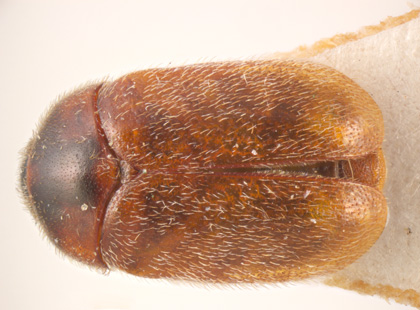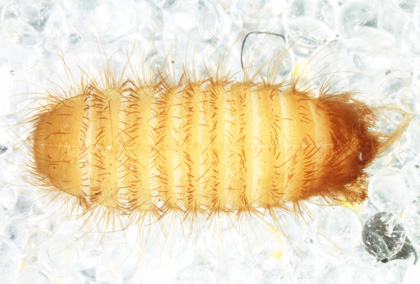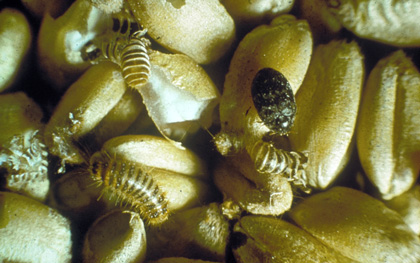Khapra beetle
About khapra beetle
Khapra beetle (Trogoderma granarium) is a serious exotic pest of stored grain, cereals and dry food stuffs.
It is very resilient and can survive in stored food, packaging and transport facilities in very low numbers under difficult conditions.
Khapra beetle is currently absent from Australia and would severely impact our international trade if it became established here.
How to identify khapra beetle
Adult beetles (Figure 1 & 2):
- are small (1.6 to 3mm long)
- are reddish-brown
- have a smooth, oval-shaped body, covered in fine hairs.


Larvae (Figure 3):
- are 1.6 to 4.5mm long
- are very hairy with a 'brush' of long spiky hairs like a tail
- are initially pale yellow and become golden-brown when they grow
- shed cast skins from the growing larvae.


Khapra beetle may be confused with other Trogoderma species in Australia (e.g. warehouse beetle). Expert diagnostics is required to identify khapra beetle.
Life cycle
Adult male and female beetles mate immediately after emergence. Adult females begin laying eggs shortly after mating, in or near host material and generally lay 50 to 100 eggs during their lifetime. Adult beetles live between 12 and 25 days and cannot fly. Adults are not commonly encountered because their offspring eat their bodies for protein.
Eggs hatch within 5 to 7 days into larvae. This is the major feeding stage and therefore the most damaging. Larvae moult four or more times, resulting in numerous cast larval skins. The larval development stage may be as short as 30 days. However, larvae can survive in a dormant state for many years in unfavourable conditions.
Hosts
Khapra beetle is a pest of stored foods and can feed on most dried plant or animal material. Their food preference is grain and cereal products, including wheat, barley, oats, rye, maize, rice, flour, malt and noodles.
It also feeds on:
- soybeans, lentils, dry peas, grain sorghums, cowpea and corn
- rolled and ground barley, ground corn, ground dog food, rolled oats, ground rice, cracked and ground wheat bran
- peanuts, pecans, walnuts and almonds.
Other commodities that often serve as hosts include:
- coriander seed, bread, dried coconuts, cornmeal, crackers, white and wholemeal wheat flour, pasta, dry baby food, pearl barley and wheat germ
- rat and mouse baits, and snail pellets.
Spread
Khapra beetle is native to India but has spread and can be found in Middle East, Asia, Africa and Europe.
It is spread through the movement of infested stored grain and dried food products (for example flour, breakfast cereals, pasta, coriander seed), or contaminated seed, machinery and packaging. The beetle can also hitchhike in shipping containers, packaging or other household furnishings imported from countries where khapra beetle is found.
Potential impact on Victorian industries
Khapra beetle is listed as number two on Australia’s National Priority Plant Pests list and if it becomes established, could have a devastating impact on Victoria’s grain, dried fruit and nut industries through lost trade.
Khapra beetle can cause up to 75 per cent grain loss due to direct feeding and also causes contamination of stored grain with cast skins and beetles, that can pose a health risk.
Due to its ability to survive without food for years and limited effective treatment options for larvae, management is extremely challenging once established.
Where to look for khapra beetle
As khapra beetle is a stored grain pest it will only be found in stored products (Figure 4) and around places where stored products are kept or transported.
Households
Khapra beetles and larvae are tiny and generally hard to see. Look for khapra beetles in the corners and bottom of bags containing grain or cereal products (for example flour, pasta, rice, oats, coriander seeds) and also check cracks and crevices of your pantry.
Importers
On receipt of imported products from countries where khapra beetle is established, check:
- stored produce including grain, rice, cotton seed, powdered milk and nuts
- containers used for storing or moving produce, including in cracks and wall linings of storage containers.
If you suspect you may have found khapra beetle:
- do not disturb the insects (this may be as simple as closing the doors on a shipping container or sealing a silo)
- take a photo
- collect a sample, if possible to do so without disturbing the insects.
Report the detection immediately to the Department of Agriculture, Fisheries and Forestry.
Growers and handlers
- Check stored grain and storage facilities regularly for new pests and unusual damage symptoms.
- Look for cast-off skins.
- Make sure you are familiar with common storage pests so you can recognise an unusual pest. The booklet 'Monitoring stored grain on-farm' located under Other publications on the Plant Health Australia website may assist.
More information
- Department of Agriculture, Fisheries and Forestry – Khapra beetle (Trogoderma granarium)
- Plant Health Australia – Khapra beetle
- CABI – Trogoderma granarium (khapra beetle) datasheet
Videos from the Department of Agriculture, Fisheries and Forestry
Photo credits
Figure 1 and 2 Khapra beetle adult and khapra beetle side profile photos courtesy of Bugwood.org
Figure 3 Khapra beetle larvae photo courtesy of James D. Young, USDA APHIS PPQ, Bugwood.org
Figure 4. Khapra beetle adults, larvae and cast skins in stored grain photo courtesy of Ministry of Agriculture and Regional Development Archive, Bugwood.org
Reporting an unusual plant insect pest or disease
Report any unusual plant pest or disease immediately using our online reporting form or by calling the Exotic Plant Pest Hotline on 1800 084 881. Early reporting increases the chance of effective control and eradication.
Please take multiple good quality photos of the pests or damage to include in your report where possible, as this is essential for rapid pest and disease diagnosis and response.
Your report will be responded to by an experienced staff member, who may seek more information about the detection and explain next steps.
Report online